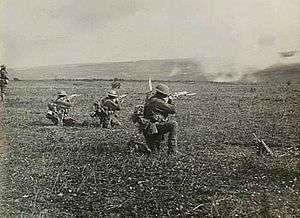12th Brigade (Australia)
| 12th Infantry Brigade | |
|---|---|
|
Members of the 45th Battalion at the Battle of the Hindenburg Line | |
| Active |
1916–1919 1921–1944 |
| Country |
|
| Branch | Australian Army |
| Type | Infantry |
| Size | Brigade |
| Part of |
4th Division 12th Division |
| Engagements |
First World War Second World War |
| Commanders | |
| Notable commanders |
Brigadier Eric Vowles Brigadier Robert Winning[1] |
The 12th Brigade was an infantry brigade of the Australian Army. Formed in 1916 as part of the all volunteer First Australian Imperial Force that was raised for overseas service during the First World War, the brigade was part of the 4th Division and fought on the Western Front until the end of the war in November 1918. During the inter-war years, the brigade was re-formed in Australia as a part-time unit; during the Second World War, the brigade was mobilised for full-time service, but did not serve overseas, undertaking garrison duties in Australia until 1944 when it was disbanded.
History
The 12th Brigade was initially raised in early 1916 as part of the expansion of the First Australian Imperial Force, which was Australia's overseas volunteer force during World War I. The brigade was formed in Egypt from a cadre of experienced personnel who had served during the Gallipoli Campaign as part of the 4th Brigade.[2] Attached to the 4th Division and consisting of four infantry battalions—the 45th, 46th, 47th and 48th Battalions[3]—it served in the trenches of the Western Front from June 1916 onwards. During this time, the brigade fought in several significant battles including the Battle of Pozières, the First Battle of Bullecourt, the Battle of Messines, the Battle of Passchendaele, and the German Spring Offensive.[4] In May 1918, the brigade was one of three that was selected to disband one of its battalions in order to provide reinforcements to other units in the Australian Corps and it was at this time that the 47th Battalion was disbanded.[5][6] The 12th Brigade's remaining battalions continued to fight after this, taking part in the final Allied offensive of the war, the Hundred Days Offensive, which was launched around Amiens in August and followed by a series of advances as the Allies broke through the Hindenburg Line.[4]
Following the end of hostilities, the brigade was disbanded in early 1919 as part of the demobilisation of the AIF. In 1921, the Australian government decided to reorganise the nation's part-time military forces in order to replicate the numerical designations and structure of the AIF.[7] As a result, the 12th Brigade was re-raised at this time as part of the 6th Military District in Tasmania as a unit of the Citizens Force. Headquartered Hobart, the brigade consisted of the 12th, 40th, 51st, and 52nd Infantry Battalions, and the 22nd Light Horse Regiment. In 1924, the 12th Brigade was reorganised as the 12th Mixed Brigade.[8] Initially the Citizens Forces units were maintained by a mixture of voluntary and compulsory service, but in 1929, the compulsory training scheme was suspended and the Citizens Force was re-formed as the "Militia", staffed on an all volunteer basis.[9]
Upon the outbreak of the Second World War in September 1939, the brigade was stationed in Tasmania, where it served in a garrison role. The brigade was assigned to the 4th Division between April and June 1943, and then assigned to the 12th Division until October 1944, when it was disbanded as part of the gradual reduction of Australia's forces that took place after 1943.[10] During this time the brigade's establishment was reduced from four battalions to three; however, the brigade's establishment changed a number of times. The following units were attached to the brigade at various times during the war: 22nd Light Horse, 40th Battalion, 12th/50th Battalion, 22nd Motor Regiment, 36th Battalion, 55th/53rd Battalion, 38th Battalion, 10th/48th Battalion, 12th/40th Battalion.[11]
See also
Notes
- ↑ "12 Infantry Brigade appointments". Order of Battle. Retrieved 2 February 2014.
- ↑ Bean 1941, p. 42.
- ↑ "Australian Military Units: First World War". Australian War Memorial. Retrieved 19 June 2010.
- 1 2 "45th Battalion". First World War, 1914–1918 units. Australian War Memorial. Retrieved 30 January 2011.
- ↑ Grey 2008, p. 111.
- ↑ "47th Battalion". Australian War Memorial. Retrieved 12 June 2010.
- ↑ Grey 2008, p. 125.
- ↑ "Australian Infantry Unit Colour Patches 1921–1949". Digger History. Retrieved 2 February 2014.
- ↑ Palazzo 2001, p. 110.
- ↑ "12 Infantry Brigade". Order of Battle. Retrieved 30 October 2009.
- ↑ "12 Infantry Brigade units". Order of Battle. Retrieved 30 October 2009.
References
- Bean, Charles (1941). The Australian Imperial Force in France, 1916. Official History of Australia in the War of 1914–1918. Volume III (12th ed.). Canberra, Australian Capital Territory: Australian War Memorial. OCLC 220623454.
- Grey, Jeffrey (2008). A Military History of Australia (3rd ed.). Melbourne: Cambridge University Press. ISBN 978-0-521-69791-0.
- Palazzo, Albert (2001). The Australian Army: A History of its Organisation 1901–2001. Melbourne: Oxford University Press. ISBN 978-0-19-551506-0.
